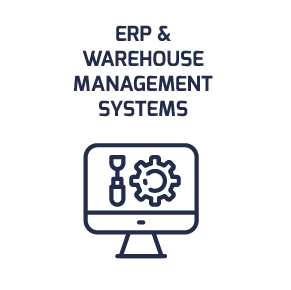Warehouse Management System (WMS)
Are you receiving the full advantages of your WMS?
We tend to view our warehouse as just a simple box containing our parts and equipment. However, we all know that it is not that simple, and managing the box can feel like juggling a lot of questions.
Is our receiving flow efficient?
Is our warehouse layout the most optimal?
How do we ensure a first-in-first-out strategy?
How do we monitor shelf-life?
Do we have the right inventory levels?
And once we have shipped our parts, how do we track them?
Your WMS is a key component in answering these questions. It helps you manage and control your daily warehouse operations from arrival of the parts into your warehouse, to the parts leaving your warehouse. It supports your processes by finding the most efficient way to receive, unpack and store parts, the retrieval processes for pick and pack, and shipping tasks of generating bills of lading, packing lists, invoices and the tracking of parts in transit.
Taking full advantage of your WMS not only helps you to streamline your supply chain management – it does this while offering you real-time transparency into your entire inventory supporting your in-inventory management with analysing inventory levels, Taking full advantage of your WMS not only helps you to streamline your supply chain management – it does this while offering you real-time transparency into your entire inventory, supporting your in-inventory management with analysing inventory levels, demand forecasting and cyclic counting. At Keel we have 15+ years of experience with ERP implementations and are experts at consulting our customers on their WMS setups. We are guided by our main rule that the system is there to assist you and support your processes, not vice versa. A concept of strategies, rules and technologies can be applied and used as your own magic wand to ensure that your warehouse is well optimized, cost efficient and a safe-working place instead of having the feeling of a blackhole.
Most major ERP systems like SAP and IFS have integrated WMS modules which can be integrated with other tools e.g. barcode scanning and RFID labelling, or more advanced robotics and augmented reality (AR) wearables. For example, user-friendly apps for use on mobile devices such as smartphones or tablets to be used directly by your warehouse personnel for real-time updates of your ERP.
KEY BUSINESS BENEFITS
- Improved operational efficiency – streamline and automate your processes, and reduce picking and shipping errors
- Warehouse space utilization – analyse your storage space and warehouse flow
- Real-time inventory transparency (or visibility?) – integrate with barcoding, RFID tagging, sensors, or other location tracking methods
- Data-driven decisions and analytics – utilize the many core metrics and performance analytics that your WMS offers for accurate demand forecasting, inventory levels, etc.
- Automation – leverage new technologies to further simply your processes and reduce workload, e.g. use of apps or analytics-driven movements
KEEL EXPERTISE
At Keel we offer a wide range of services ranging from consulting you on the most optimal warehouse strategy, analysis and configuration, and development of supporting applications.

WWe are specialized in ERP & Warehouse Management systems such as IFS and SAP. Our IT tools and services are specifically developed to collect, analyse, optimize and structure asset data in companies that operate in the Energy Sector.
- Setup of WMS in accordance with your most efficient warehouse strategy
- Configuration of automated work processes
- Implementation of barcoding or other real-time tracking methods
- Development of integrated applications for ERP systems (IFS, SAP) workflow optimization
- Define data benchmarking. Implement analytics

Through our engineering and consultancy services we can assist with:
- Defining your warehouse strategy including concept and rules for automation
- Analysis of optimal warehouse layout and storage structure
- Inventory management; analysis of inventory levels requirements
- Master data management, classification of materials, define category, class, type
- Analysis of inventory requirements
- Advise on correct storage and handling of e.g. rubber parts and IT equipment
- Advise on preservation and maintenance of stored equipment to ensure in accordance with requirements from external stakeholders such as customers, authorities and classification societies
- Policy and procedure development to ensure clear guidance and transactional discipline in accordance with regulations and standards, e.g. cyclic inventory count, storage requirements, etc.
ADDITIONAL SERVICES
We can also assist you with inventory routine work:
- Physical inventory count
- Master data collection and implementation
- Cleansing of existing master data and transactional data
- Inventory clean-up through physical equipment and part condition evaluation
- Materials classification, GTIN and HS codes
Read more on our product sheet:
We are ready to help!
Request consultation, ask a question or share your feedback. Just get in touch!





